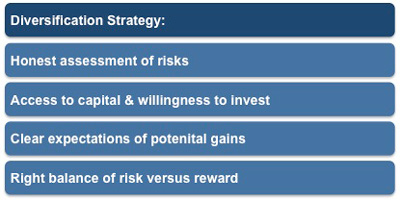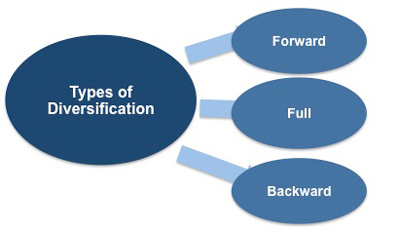Diversification Strategy

Diversification is one of the four alternative growth strategies in the Ansoff Matrix. A diversification strategy achieves growth by developing new products for completely new markets. As such, it is inherently more risky than product development because by definition the organization has little or no experience of the new market. In addition, the new skills needed both in terms of marketing and operations often require substantial investment. This is usually achieved by acquiring an organization already operating in the new market.
For an organization to adopt such a strategy it must have a clear idea of what it expects to gain in terms of its growth. It also needs to make an honest assessment of the risks involved. Diversification often fails because organizations that attempt it are doing so because they have uncompetitive products in shrinking markets and a diversification strategy represents a desperate attempt to reinvent themselves. However, for those organizations that find the right balance between risk and reward, a marketing strategy of diversification can be highly rewarding.
 |
This strategy is unlikely to come as a surprise to you, as it will have been intimated in many executive discussions and communications as a way the organization can achieve its ambitious or aggressive growth targets.
By regularly reading press articles on your organization and its annual report you will be able to ascertain if this type of strategy is one under consideration. If you are aware of the accumulation of investment funds or substantial pressures from your competitors on your market share or product range, then these are the type of pre-conditions that forewarn of a diversification strategy.
If you are involved in defining or implementing a diversification strategy you will be aware of the discomfort or risk that occurs when working outside your existing knowledge base. Not all such strategies are successful, and even those that are in the short term may falter in the long run if they are unable to match the R&D of their competitors.
These two examples illustrate the risks involved:
In the UK, Virgin's move into trains has not been as successful as was initially hoped, even though they had some experience in the transport market. This poor performance might have had an impact on the overall strength of the brand due to the criticisms of the rail service. But Richard Branson's image has done much to minimize the impact and enhance the corporation's ability to truly segment its services.
Nokia were extremely successful when they diversified into cell phone manufacturing from their original focus as a producer of paper products. They became the European market leader, but they have recently suffered a setback with the introduction of Smartphones. It will take them time to respond to this setback and restore their market position.
Diversification can occur at two levels: either at the business unit level or at an organizational level. When it happens at the business unit level, you will most likely see your organization expanding into a new segment of its current market. At the organizational level, you will most likely find you are involved in integrating a new organization into your existing one.
As with each of the other growth strategies there are three broad approaches to how your organization implements a policy of diversification:
• Full Diversification
• Backward Diversification
• Forward Diversification
Some organizations refer to these types of diversification as different 'integration' approaches because this is actually what happens. The new product or service and its market must be 'integrated' into the organizational structure to be successful.
 |
Full Diversification - this approach is the most risky as you are offering a totally new product or service to an unknown market. It will also take considerable time to accomplish. An example of this strategy would be: A fresh trout distributor decides to diversify into selling insurance.
Backward diversification - this is where your organization decides to diversify by offering a product or service that relates to the preceding stage of your current product or service. For example:
The distributor decides to invest in a Scottish trout farm, thereby encroaching on the role of his or her supplier.
Forward diversification - this is the situation where your organization diversifies into the products or services that relate to a later stage that follows your current offering. For example:
The distributor negotiates contracts directly with the supermarkets and other end users by selling online, negating the need to work with wholesalers.
In each of these examples the distributor would need to learn new skills and methods of operation. In the examples of forward and backward diversification those skills are not so alien to the distributor because the product is essentially the same. But the expertise in running a trout farm, in negotiating contracts, and setting up a reliable online shop to the public will require new skills to be successful.
In this example, the option of full diversification is obviously very risky indeed. The distributor is not involved in the insurance business and few of the skills that exist within his or her existing business will be transferable to the new one. This type of radical diversification can work if the company is cash rich and feels as though they would benefit from investing in a completely different type of business, perhaps one that they believe has a better long-term future than their current enterprise.
You may also be interested in: Introduction to the Ansoff Matrix, Market Penetration Strategy, Market Development Strategy, Product Development Strategy and Diversification Strategy.



